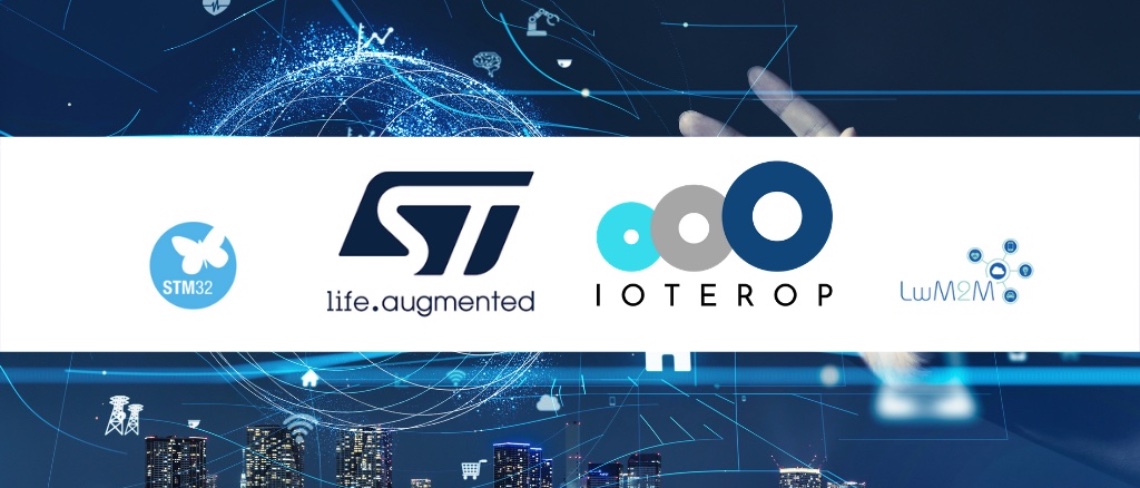How can companies manage a plethora of smart sensors and computing devices remotely for years on end with minimal to no maintenance necessary? The question is as tricky as it is critical since the answer will determine the Internet of Things’ future. Indeed, for a product to last years in the field, it must have an extremely low-power consumption. Yet, a smart system must regularly communicate with a cloud to share data, receive updates, and more. And any wireless transmission is by nature power-hungry. Teams must, therefore, find ways to optimize their connection to a remote server if they hope to ship a viable IoT solution.
ST and IoTerop, a French company specializing in Lightweight Machine-to-Machine (LwM2M) device management over Narrow Band-IoT, offer a way to help engineers working on an STM32 microcontroller solve this crucial problem. IoTerop, an ST Authorized Partner, created IOWA, a software development kit that simplifies the creation of an LwM2M solution. The software stack sits on top of ST’s middleware and includes a vastly optimized library. Developers thus have access to an abstraction layer that hastens code creation. IOWA also works in conjunction with ALASKA, IoTerop’s device management platform on the cloud, and CONNECTICUT, its testing environment. Hence, let’s explore why an STM32 MCU running IoTerop’s software can solve the challenges IoT engineers are currently facing.
1. IOWA and the Low-Power Challenge
MQTT vs. LwM2M
When starting a project, such as a smart meter, one fundamental challenge stems from selecting a communication protocol. Message Queue Telemetry Transport (MQTT) is the de facto protocol when dealing with clouds for good reason. Its publish-subscribe model is reliable, and it uses the very familiar TCP protocol. However, the heads that gave birth to MQTT never had the consumption of ultra-low power IoT products in mind. LwM2M, on the other hand, is inherently more efficient since, at its very core, it is a constrained application protocol (CoAP), meaning that it was designed to fit small devices and require very little power. Hence, IOWA is helpful because it facilitates the creation of an LwM2M application on an STM32 system.
Only 5 KB of RAM
IoTerop takes advantage of the baked-in advantages of LwM2M and goes a step further. For instance, the company takes advantage of ST’s crypto cores to optimize encryption and decryption operations. IoTerop is also working on utilizing deep sleep modes and other power-saving mechanisms available in STM32 MCUs. Additionally, IOWA’s memory footprint is vastly smaller than competing solutions. Indeed, the entire library fits in only 30 KB of Flash and 5 KB of RAM. Developers can thus more easily rely on IOWA since it will fit small memory configurations and low-power processors.
2. IOWA and the Future-Proofing Challenge
MQTT vs. LwM2M Part II
Another challenge engineers must wrestle with pertains to the use of proprietary solutions. Traditionally, teams prioritize standards because they offer interoperability and continuity. The chance of a well-established industry protocol dying is slim to none. On the other hand, a proprietary technology can be more volatile and less secure. When faced with this conflict, many developers tend to lean toward LwM2M. Indeed, MQTT doesn’t define a payload, for instance. As a result, many developers use proprietary solutions, which locks them into a particular vendor ecosystem. LwM2M doesn’t have this problem since the standard is far more comprehensive. It defines payload, data models, includes device management services, and works with TLS and DTLS 1.2+ for additional security.
Thinking About Future-Proofing
Developers looking to take advantage of LwM2M on STM32 MCUs can turn to IOWA, which implements all of the standard’s features and more. For example, the SDK implements a firmware update and remote diagnostic capabilities. Put simply, IoTerop leverages ST’s middleware, and LwM2M features to help manage devices throughout their lifecycle. Indeed, a common difficulty is the ability to manage a device 10 years from now in a tech world that moves incredibly fast. By relying on standards and working closely with ST, the French company ensures that users can continue to patch software, connect to the cloud, provision new devices, add new functionalities, and more for the entire lifecycle of their product.
3. IOWA and the Development Time Challenge
Writing Code Can Be Up to 70% Quicker
Programmers always ask themselves one simple question: “How long will it take me to write this application?” It’s the reason why many choose to use abstraction layers. Having to write everything from scratch is often time- and cost-prohibitive. IOWA is, therefore, an essential part of the development of IoT systems as adopting it greatly hastens developments. However, there’s more than meets the eye. Thanks to CONNECTICUT, engineers can more rapidly test their applications to shorten their time to market further. Similarly, adopting the ALASKA platform means coming up with a cloud platform faster. Moreover, the IOWA SDK works within STM32CubeIDE, the first free ST IDE with STM32CubeMX built-in. As a result, teams can take a board like the P-L496G-CELL02, all the ST low-level software, and expansions, such as X-CUBE-CELLULAR, and expect to release a commercial IoT product in less than three months when pairing with IoTerop’s solutions.
